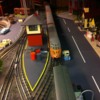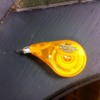I am doing a road and am having trouble deciding whether to do stripes on the road.
The road is a winding road through woods, next to the track, with cable guard rails, pretty narrow but passes for two lanes of width. Circa 40's - 50's time frame.
I've seen some model roads that have a single white stripe in the middle of the road, to divide lanes. Was that a method used in the past instead of the double yellow lines?
I don't really want to go all out and do white lines on the outsides and the double yellow in the middle and would probably prefer a single white stripe in the middle if this has some basis in reality, or just the double yellow line in the middle if not, either option without the side white lines.
I don't want this road to look too polished, just a little road in the back woods.
Thanks for any info you can share.














